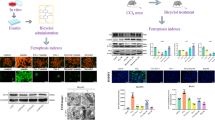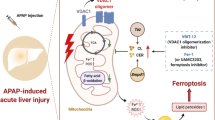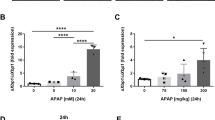Abstract
It is essential to further characterize liver injury aimed at developing novel therapeutic approaches. This study investigated the mechanistic basis of genipin against carbon tetrachloride (CCl4)-triggered acute liver injury concerning ferroptosis, a novel discovered modality of regulated cell death. All experiments were performed using hepatotoxic models upon CCl4 exposure in mice and human hepatocytes in vitro. Immunohistochemistry, immunoblotting, molecular docking, RNA-sequencing and ultra-high-performance liquid chromatography-tandem mass spectrometry (UHPLC-MS/MS) were conducted. CCl4 intoxication was manifested with lipid peroxidation-dictated ferroptotic cell death, together with changes in a cascade of ferroptosis-associated events and several regulatory pathways. Both the administration of genipin and ferrostatin-1 (Fer-1) significantly prevented this hepatotoxicity in response to CCl4 intoxication via upregulating GPX4 and xCT (i.e., critical regulators of ferroptosis). RNA-sequencing unraveled that arachidonic acid metabolism was considerably influenced upon genipin treatment. Accordingly, genipin treatment attenuated arachidonate 15-lipoxygenase (ALOX15)-launched lipid peroxidation in terms of UHPLC-MS/MS analysis and inflammation. In vitro, genipin supplementation rescued erastin-induced hepatocellular inviability and lipid ROS accumulation. The siRNA knockdown of GPX4 partially abrogated the protective effects of genipin on erastin-induced cytotoxicity, whereas the cytotoxicity was less severe in the presence of diminished ALOX15 expression in L-O2 cells. In conclusion, our findings uncovered that genipin treatment protects against CCl4-triggered acute liver injury by abrogating hepatocyte ferroptosis, wherein the pharmacological modification of dysregulated GPX4 and ALOX15-launched lipid peroxidation was responsible for underlying medicinal effects as molecular basis.







Similar content being viewed by others
Data Availability
The datasets used or analyzed during the current study are available from the corresponding author on reasonable request.
References
Tak J, Kim YS, Kim TH, Park GC, Hwang S, Kim SG (2022) Galpha12 overexpression in hepatocytes by ER stress exacerbates acute liver injury via ROCK1-mediated miR-15a and ALOX12 dysregulation. Theranostics 12:1570–1588
Zhao T, Mao L, Yu Z, Hui Y, Feng H, Wang X, Lin L, Fan X, Chen X, Wang B, Cao X, Sun C (2021) Therapeutic potential of bicyclol in liver diseases: Lessons from a synthetic drug based on herbal derivative in traditional chinese medicine. Int Immunopharmacol 91:107308
Cheng N, Ren N, Gao H, Lei X, Zheng J, Cao W (2013) Antioxidant and hepatoprotective effects of Schisandra chinensis pollen extract on CCl4-induced acute liver damage in mice. Food Chem Toxicol 55:234–240
Popovic D, Kocic G, Katic V, Zarubica A, Velickovic LJ, Nickovic VP, Jovic A, Veljkovic A, Petrovic V, Rakic V, Jovic Z, Ulrih NP, Sokolovic D, Stojanovic M, Stankovic M, Radenkovic G, Nikolic GR, Lukac capital A C, Milosavljevic A, Sokolovic D (2019) Anthocyanins Protect Hepatocytes against CCl4-Induced Acute Liver Injury in Rats by Inhibiting Pro-inflammatory mediators, Polyamine Catabolism, Lipocalin-2, and Excessive Proliferation of Kupffer Cells. Antioxidants (Basel) 8
Ahn M, Kim J, Bang H, Moon J, Kim GO, Shin T (2016) Hepatoprotective effects of allyl isothiocyanate against carbon tetrachloride-induced hepatotoxicity in rat. Chem Biol Interact 254:102–108
Unsal V, Cicek M, Sabancilar I (2021) Toxicity of carbon tetrachloride, free radicals and role of antioxidants. Rev Environ Health 36:279–295
Doll S, Freitas FP, Shah R, Aldrovandi M, da Silva MC, Ingold I, Goya Grocin A, Xavier da Silva TN, Panzilius E, Scheel CH, Mourao A, Buday K, Sato M, Wanninger J, Vignane T, Mohana V, Rehberg M, Flatley A, Schepers A, Kurz A, White D, Sauer M, Sattler M, Tate EW, Schmitz W, Schulze A, O’Donnell V, Proneth B, Popowicz GM, Pratt DA, Angeli JPF, Conrad M (2019) FSP1 is a glutathione-independent ferroptosis suppressor. Nature 575:693–698
Stockwell BR, Jiang X, Gu W (2020) Emerging mechanisms and Disease Relevance of Ferroptosis. Trends Cell Biol 30:478–490
Fujii J, Homma T, Osaki T (2022) Superoxide Radicals in the execution of cell death. Antioxid (Basel) 11
Kagan VE, Mao G, Qu F, Angeli JP, Doll S, Croix CS, Dar HH, Liu B, Tyurin VA, Ritov VB, Kapralov AA, Amoscato AA, Jiang J, Anthonymuthu T, Mohammadyani D, Yang Q, Proneth B, Klein-Seetharaman J, Watkins S, Bahar I, Greenberger J, Mallampalli RK, Stockwell BR, Tyurina YY, Conrad M, Bayir H (2017) Oxidized arachidonic and adrenic PEs navigate cells to ferroptosis. Nat Chem Biol 13:81–90
Ajoolabady A, Tang D, Kroemer G, Ren J (2022) Ferroptosis in hepatocellular carcinoma: mechanisms and targeted therapy. Br J Cancer.
Ma C, Han L, Zhu Z, Heng Pang C, Pan G (2022) Mineral metabolism and ferroptosis in non-alcoholic fatty liver diseases. Biochem Pharmacol 205:115242
Mao L, Zhao T, Song Y, Lin L, Fan X, Cui B, Feng H, Wang X, Yu Q, Zhang J, Jiang K, Wang B, Sun C (2020) The emerging role of ferroptosis in non-cancer liver diseases: hype or increasing hope? Cell Death Dis 11:518
Qi J, Kim JW, Zhou Z, Lim CW, Kim B (2020) Ferroptosis affects the progression of nonalcoholic steatohepatitis via the modulation of lipid peroxidation-mediated cell death in mice. Am J Pathol 190:68–81
Dai C, Li H, Wang Y, Tang S, Velkov T, Shen J (2021) Inhibition of oxidative stress and ALOX12 and NF-kappaB pathways contribute to the Protective Effect of Baicalein on Carbon Tetrachloride-Induced Acute Liver Injury. Antioxid (Basel) 10
Tsai WH, Yang CC, Li PC, Chen WC, Chien CT (2013) Therapeutic potential of traditional chinese medicine on inflammatory diseases. J Tradit Complement Med 3:142–151
Yim JS, Kim YS, Moon SK, Cho KH, Bae HS, Kim JJ, Park EK, Kim DH (2004) Metabolic activities of ginsenoside Rb1, baicalin, glycyrrhizin and geniposide to their bioactive compounds by human intestinal microflora. Biol Pharm Bull 27:1580–1583
Wang Y, Zhao T, Deng Y, Hou L, Fan X, Lin L, Zhao W, Jiang K, Sun C (2019) Genipin Ameliorates Carbon Tetrachloride-Induced Liver Injury in Mice via the Concomitant Inhibition of Inflammation and Induction of Autophagy. Oxid Med Cell Longev 2019:3729051
Chen X, Kang R, Kroemer G, Tang D (2021) Broadening horizons: the role of ferroptosis in cancer. Nat Rev Clin Oncol 18:280–296
Cho HI, Kim SJ, Choi JW, Lee SM (2016) Genipin alleviates sepsis-induced liver injury by restoring autophagy. Br J Pharmacol 173:980–991
Yamada N, Karasawa T, Wakiya T, Sadatomo A, Ito H, Kamata R, Watanabe S, Komada T, Kimura H, Sanada Y, Sakuma Y, Mizuta K, Ohno N, Sata N, Takahashi M (2020) Iron overload as a risk factor for hepatic ischemia-reperfusion injury in liver transplantation: potential role of ferroptosis. Am J Transplant 20:1606–1618
Stancic A, Velickovic K, Markelic M, Grigorov I, Saksida T, Savic N, Vucetic M, Martinovic V, Ivanovic A, Otasevic V (2022) Involvement of ferroptosis in Diabetes-Induced Liver Pathology. Int J Mol Sci 23
Chen J, Li X, Ge C, Min J, Wang F (2022) The multifaceted role of ferroptosis in liver disease. Cell Death Differ 29:467–480
Tang D, Chen X, Kang R, Kroemer G (2021) Ferroptosis: molecular mechanisms and health implications. Cell Res 31:107–125
Liu T, Shu J, Liu Y, Xie J, Li T, Li H, Li L (2022) Atorvastatin attenuates ferroptosis-dependent myocardial injury and inflammation following coronary microembolization via the Hif1a/Ptgs2 pathway. Front Pharmacol 13:1057583
Jiang L, Kon N, Li T, Wang SJ, Su T, Hibshoosh H, Baer R, Gu W (2015) Ferroptosis as a p53-mediated activity during tumour suppression. Nature 520:57–62
Tarangelo A, Dixon S (2018) The p53-p21 pathway inhibits ferroptosis during metabolic stress. Oncotarget 9:24572–24573
Yang WS, Stockwell BR (2008) Synthetic lethal screening identifies compounds activating iron-dependent, nonapoptotic cell death in oncogenic-RAS-harboring cancer cells. Chem Biol 15:234–245
Ma XH, Liu JH, Liu CY, Sun WY, Duan WJ, Wang G, Kurihara H, He RR, Li YF, Chen Y, Shang H (2022) ALOX15-launched PUFA-phospholipids peroxidation increases the susceptibility of ferroptosis in ischemia-induced myocardial damage. Signal Transduct Target Ther 7:288
Jaeschke H, Adelusi OB, Ramachandran A (2021) Ferroptosis and Acetaminophen Hepatotoxicity: are we going down another rabbit. Hole? Gene Expr 20:169–178
Huang GJ, Deng JS, Chiu CS, Liao JC, Hsieh WT, Sheu MJ, Wu CH (2012) Hispolon Protects against Acute Liver Damage in the Rat by Inhibiting Lipid Peroxidation, Proinflammatory Cytokine, and Oxidative Stress and Downregulating the Expressions of iNOS, COX-2, and MMP-9. Evid Based Complement Alternat Med 2012:480714
Zahedi K, Barone SL, Xu J, Steinbergs N, Schuster R, Lentsch AB, Amlal H, Wang J, Casero RA Jr, Soleimani M (2012) Hepatocyte-specific ablation of spermine/spermidine-N1-acetyltransferase gene reduces the severity of CCl4-induced acute liver injury. Am J Physiol Gastrointest Liver Physiol 303:G546–560
Popovic D, Kocic G, Katic V, Jovic Z, Zarubica A, Jankovic Velickovic L, Nikolic V, Jovic A, Kundalic B, Rakic V, Ulrih NP, Skrt M, Sokolovic D, Dinic L, Stojanovic M, Milosavljevic A, Velickovic F, Sokolovic D (2019) Protective effects of anthocyanins from bilberry extract in rats exposed to nephrotoxic effects of carbon tetrachloride. Chem Biol Interact 304:61–72
Shah MD, Gnanaraj C, Haque AT, Iqbal M (2015) Antioxidative and chemopreventive effects of Nephrolepis biserrata against carbon tetrachloride (CCl4)-induced oxidative stress and hepatic dysfunction in rats. Pharm Biol 53:31–39
Yuan Y, Yucai L, Lu L, Hui L, Yong P, Haiyang Y (2022) Acrylamide induces ferroptosis in HSC-T6 cells by causing antioxidant imbalance of the XCT-GSH-GPX4 signaling and mitochondrial dysfunction. Toxicol Lett 368:24–32
Knockaert L, Berson A, Ribault C, Prost PE, Fautrel A, Pajaud J, Lepage S, Lucas-Clerc C, Begue JM, Fromenty B, Robin MA (2012) Carbon tetrachloride-mediated lipid peroxidation induces early mitochondrial alterations in mouse liver. Lab Invest 92:396–410
Han D, Yao Y, Chen L, Miao Z, Xu S (2022) Apigenin ameliorates di(2-ethylhexyl) phthalate-induced ferroptosis: the activation of glutathione peroxidase 4 and suppression of iron intake. Food Chem Toxicol 164:113089
Li C, Deng X, Xie X, Liu Y, Friedmann Angeli JP, Lai L (2018) Activation of glutathione peroxidase 4 as a novel anti-inflammatory strategy. Front Pharmacol 9:1120
Wu SJ, Lin YH, Chu CC, Tsai YH, Chao JC (2008) Curcumin or saikosaponin a improves hepatic antioxidant capacity and protects against CCl4-induced liver injury in rats. J Med Food 11:224–229
Kuhn H, Humeniuk L, Kozlov N, Roigas S, Adel S, Heydeck D (2018) The evolutionary hypothesis of reaction specificity of mammalian ALOX15 orthologs. Prog Lipid Res 72:55–74
Yang WS, Kim KJ, Gaschler MM, Patel M, Shchepinov MS, Stockwell BR (2016) Peroxidation of polyunsaturated fatty acids by lipoxygenases drives ferroptosis. Proc Natl Acad Sci U S A 113:E4966–4975
Singh NK, Rao GN (2019) Emerging role of 12/15-Lipoxygenase (ALOX15) in human pathologies. Prog Lipid Res 73:28–45
Markworth JF, Mitchell CJ, D’Souza RF, Aasen KMM, Durainayagam BR, Mitchell SM, Chan AHC, Sinclair AJ, Garg M, Cameron-Smith D (2018) Arachidonic acid supplementation modulates blood and skeletal muscle lipid profile with no effect on basal inflammation in resistance exercise trained men. Prostaglandins Leukot Essent Fatty Acids 128:74–86
Torres LR, Santana FC, Torres-Leal FL, Melo IL, Yoshime LT, Matos-Neto EM, Seelaender MC, Araujo CM, Cogliati B, Mancini-Filho J (2016) Pequi (Caryocar brasiliense Camb.) Almond oil attenuates carbon tetrachloride-induced acute hepatic injury in rats: antioxidant and anti-inflammatory effects. Food Chem Toxicol 97:205–216
Chan CC, Lee KC, Huang YH, Chou CK, Lin HC, Lee FY (2014) Regulation by resveratrol of the cellular factors mediating liver damage and regeneration after acute toxic liver injury. J Gastroenterol Hepatol 29:603–613
Fan X, Lin L, Cui B, Zhao T, Mao L, Song Y, Wang X, Feng H, Qingxiang Y, Zhang J, Jiang K, Cao X, Wang B, Sun C (2020) Therapeutic potential of genipin in various acute liver injury, fulminant hepatitis, NAFLD and other non-cancer liver diseases: more friend than foe. Pharmacol Res 159:104945
You H, Wang L, Bu F, Meng H, Huang C, Fang G, Li J (2022) Ferroptosis: Shedding Light on Mechanisms and Therapeutic Opportunities in Liver Diseases. Cells 11
Hou W, Xie Y, Song X, Sun X, Lotze MT, Zeh HJ 3rd, Kang R, Tang D (2016) Autophagy promotes ferroptosis by degradation of ferritin. Autophagy 12:1425–1428
Song X, Zhu S, Chen P, Hou W, Wen Q, Liu J, Xie Y, Liu J, Klionsky DJ, Kroemer G, Lotze MT, Zeh HJ, Kang R, Tang D (2018) AMPK-Mediated BECN1 phosphorylation promotes ferroptosis by directly blocking System Xc(-) activity. Curr Biol 28:2388–2399e2385
Cai X, Hua S, Deng J, Du Z, Zhang D, Liu Z, Khan NU, Zhou M, Chen Z (2022) Astaxanthin activated the Nrf2/HO-1 pathway to Enhance Autophagy and inhibit ferroptosis, ameliorating Acetaminophen-Induced Liver Injury. ACS Appl Mater Interfaces 14:42887–42903
Liu J, Huang C, Liu J, Meng C, Gu Q, Du X, Yan M, Yu Y, Liu F, Xia C (2022) Nrf2 and its dependent autophagy activation cooperatively counteract ferroptosis to alleviate acute liver injury. Pharmacol Res 187:106563
Funding
The authors declare that no funds, grants, or other support were received during the preparation of this manuscript.
Author information
Authors and Affiliations
Contributions
Conception or design of the work: Xiaofei Fan, Xiaoyu Wang, Yangyang Hui and Chao Sun; Data collection: Tianming Zhao, Lihong Mao, Binxin Cui and Weilong Zhong; Drafting the article and critical revision of the article: Chao Sun; Final ap-proval of the version to be published: all authors.
Corresponding author
Ethics declarations
Ethical approval
All animal studies were approved by the Institutional Animal Care and Use Committee at Tianjin Medical University General Hospital (IRB2021-DWFL-142).
Competing interest
All authors declare no conflict of interest.
Additional information
Xiaofei Fan, Xiaoyu Wang and Yangyang Hui contributed equally to this work.
Publisher’s Note
Springer Nature remains neutral with regard to jurisdictional claims in published maps and institutional affiliations.
Electronic supplementary material
Below is the link to the electronic supplementary material.
Rights and permissions
Springer Nature or its licensor (e.g. a society or other partner) holds exclusive rights to this article under a publishing agreement with the author(s) or other rightsholder(s); author self-archiving of the accepted manuscript version of this article is solely governed by the terms of such publishing agreement and applicable law.
About this article
Cite this article
Fan, X., Wang, X., Hui, Y. et al. Genipin protects against acute liver injury by abrogating ferroptosis via modification of GPX4 and ALOX15-launched lipid peroxidation in mice. Apoptosis 28, 1469–1483 (2023). https://doi.org/10.1007/s10495-023-01867-9
Accepted:
Published:
Issue Date:
DOI: https://doi.org/10.1007/s10495-023-01867-9




